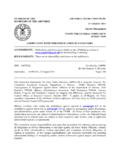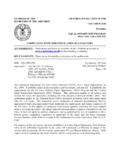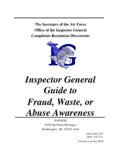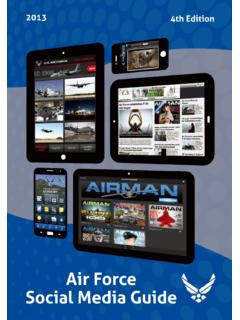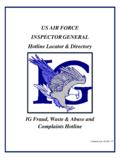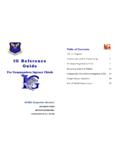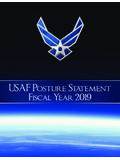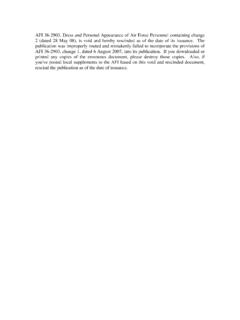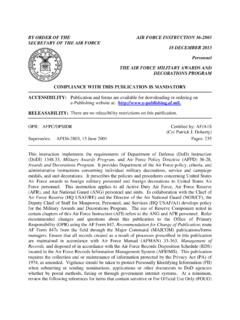Transcription of BY ORDER OF THE AIR FORCE INSTRUCTION 1-2 SECRETARY …
1 BY ORDER OF THE SECRETARY OF THE AIR FORCE AIR FORCE INSTRUCTION 1-2 8 MAY 2014 Air FORCE Culture commander S RESPONSIBILITIES COMPLIANCE WITH THIS PUBLICATION IS MANDATORY ACCESSIBILITY: This publication is available for downloading from the e-Publishing website at RELEASABILITY: There are no releasability restrictions on this publication. OPR: SAF/IG Certified by: AF/CV (General Larry O. Spencer) Pages: 6 This Air FORCE INSTRUCTION (AFI) implements Air FORCE Policy Directive 1, Air FORCE Culture, and echoes the standards in AFI 1-1, Air FORCE Standards. This publication establishes broad responsibilities and expectations of commanders in the Air FORCE . This publication applies to all Air FORCE uniformed personnel (Regular, Air FORCE Reserve, and Air National Guard) and civilian personnel. Although this guidance amplifies expectations of commanders, nothing in this AFI should be deemed to create a right or entitlement for the individual that does not otherwise exist in law or policy.
2 This AFI may not be supplemented at any level. Refer all recommended changes about this publication to the office of primary responsibility (OPR) using the AF Form 847, Recommendation for Change of Publication. As a foundational publication, this publication has been granted an exception to policy regarding tiering of wing/unit level requirements in accordance with AFI 33-360, Publications and Forms Management, paragraph Submit requests for waivers through the chain of command to the Publication OPR. Ensure that all records created as a result of processes prescribed in this publication are maintained in accordance with (IAW) Air FORCE Manual (AFMAN) 33-363, Management of Records, and disposed of IAW Air FORCE Records Disposition Schedule (RDS) located in the Air FORCE Records Information Management System (AFRIMS).
3 1. Scope of Applicability. This INSTRUCTION applies specifically to commissioned officers holding command positions in the Regular or Reserve Components (Active Duty, Reserve, and Air National Guard), but the principles and methods described herein should be applied by leaders at all levels ( civilian directors of military organizations, non-commissioned officers, etc.). 2 AFI1-2 8 May 2014 2. commander Conduct. Special authorities and responsibilities are inherent with command. In addition to leading people to accomplish an assigned mission, commanders have the lawful authority and responsibility to promote and safeguard the morale, physical well-being, and the general welfare of persons under their command. Commanders are expected to display exemplary conduct as outlined in US law: All commanding officers and others in authority in the Air FORCE are required: (1) to show in themselves a good example of virtue, honor, patriotism, and subordination; (2) to be vigilant in inspecting the conduct of all persons who are placed under their command; (3) to guard against and suppress all dissolute and immoral practices, and to correct, according to the laws and regulations of the Air FORCE , all persons who are guilty of them; and (4) to take all necessary and proper measures, under the laws, regulations, and customs of the Air FORCE , to promote and safeguard the morale, the physical well-being, and the general welfare of the persons under their command or charge.
4 - Title 10 USC 8583 Accordingly, commanders must be above reproach, both morally and ethically, and exemplify Air FORCE Core Values and standards in their professional and personal lives. 3. commander s Duties and Responsibilities. Execute the Mission. Commanders hold the authority and responsibility to act and to lead their units to accomplish the mission. Air FORCE commanders have threefold mission execution responsibilities: primary mission, Air Expeditionary FORCE (AEF) readiness, and mission assurance command and control. Commanders must apply good risk management, accept risk and manage resources to adjust the timing, quality, and quantity of their support to meet the requirements of the supported commander . Primary mission execution. This is the mission described in the Mission Directive, Designed Operational Capability statement, or specified by ORDER of a superior commander .
5 This may be a day-to-day, in-garrison mission, or it may be an expeditionary, deployed mission. Commanders must ensure their unit is able to execute its primary mission at any time. AEF readiness. The AEF model provides an adaptable, agile FORCE , able to respond to dynamic worldwide events. Commanders must train and develop their Airmen to support AEF taskings. Mission Assurance Command and Control. Within the scope of their authority, commanders must, at all times, maintain the ability to command and control their units against all relevant threats and hazards to assure mission success. Lead People. Effectively leading people is the art of command. Commanders must maintain effective communication processes and ensure unit members are well disciplined, trained and developed.
6 At all times, commanders must lead by personal example and pay judicious attention to the welfare and morale of their subordinates. Commanders will enforce AFI1-2 8 May 2014 3 the Air FORCE cultural standards on conduct, performance, and discipline outlined in AFI 1-1, Air FORCE Standards. Further, commanders will establish and maintain a healthy command climate which fosters good ORDER and discipline, teamwork, cohesion and trust. A healthy climate ensures members are treated with dignity, respect, and inclusion, and does not tolerate harassment, assault, or unlawful discrimination of any kind. Communication. Commanders must develop a two-way vertical and lateral communication system which is agile enough to respond to changes in the environment in a timely manner. In ORDER to develop understanding, intent, and trust, commanders must transmit goals, priorities, values, and expectations, while encouraging feedback.
7 Discipline. Commanders must cultivate a culture of compliance and accountability while promoting unit and mission pride. Command climate, customs and courtesies, uniform wear, physical fitness, and attention to detail are some indicators of the discipline of a unit. Training. Commanders must ensure their units are adequately trained. Unit training should take a building-block approach. Individuals must be proficient in career-field specific skills before incorporating those skills into team and unit training. Unit training spanning the entire scope of the unit mission should include total FORCE , joint, or partner-nation opportunities whenever possible. Training should replicate the distributed, chaotic and uncertain nature of expected operating environments. Development. Commanders will support the professional and personal development of subordinates.
8 Professional development includes formal mentoring, professional military education, academic opportunities, and other broadening opportunities. Personal development strengthens physical, mental, social and spiritual resiliency in an effort to build well-rounded Airmen. Quality of Life Engagement. Commanders have the unique authority and responsibility to engage in the lives of their subordinates, where appropriate, to improve quality of life, promote unit morale, and ensure all members are treated with dignity and respect. Commanders must be aware of on- and off-duty factors affecting the climate and morale of their units. Manage Resources. Commanders are entrusted with resources to accomplish a stated mission. Those resources include: manpower, funds, equipment, facilities and environment, guidance, and Airmen s time.
9 Commanders must consider risk in their stewardship of scarce resources to ensure effective and efficient mission accomplishment. As part of managing their resources, higher echelon commanders must ensure adequate resources are provided to subordinate commanders. Likewise, subordinate commanders must inform higher echelon commanders of resource shortfalls. Manpower. A commander s stewardship of personnel to meet evolving mission requirements is vital to mission success. Accurate reporting of manning levels, personnel rotations and readiness is vital when communicating with higher headquarters. Funds. Commanders must base their budgetary decisions on mission requirements. Budgets must be credible, defensible, executable, and should contribute to cost-effective mission execution. Accountability and judicious management of funds 4 AFI1-2 8 May 2014 must be command emphasis items aligned with command priorities.
10 Make every effort to return excess funds to higher echelon commanders for reallocation. Equipment. Equipment and supplies must be properly accounted for, well maintained, and adequate for the assigned mission. Like manning and training levels, equipment status is a vital part of readiness reporting to higher headquarters. Facilities and Environment. Commanders must develop sustainable installations and implement appropriate asset management principles for built and natural assets. Regularly scheduled inspections, maintenance, and upgrades must be coordinated with appropriate agencies. Guidance. Unit members must have access to all command, technical, legal and procedural guidance necessary for mission accomplishment. When necessary, commanders will publish guidance to document unit-specific processes and standards.

